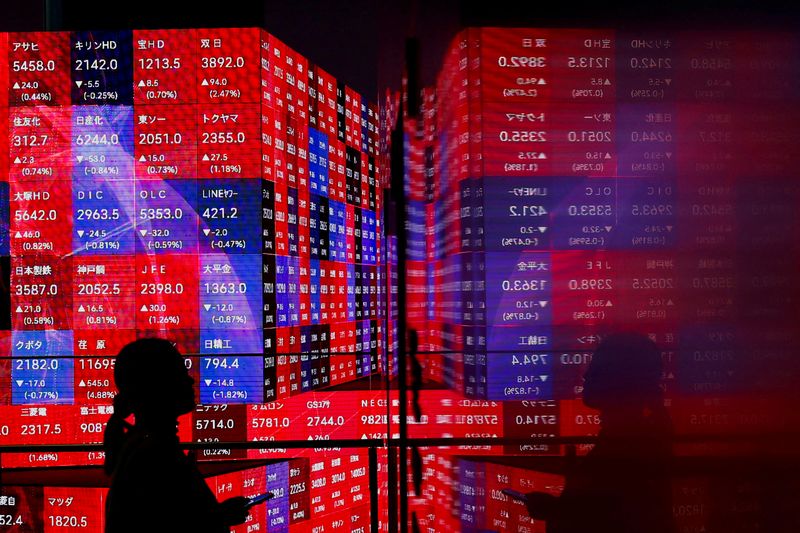By Wayne Cole
SYDNEY (Reuters) – Asian stocks were steady on Monday ahead of central bank meetings that are widely expected to deliver two more rate cuts and key U.S. inflation figures that should flash a green light for more easing there.
A holiday in Japan made for thin trading and MSCI’s broadest index of Asia-Pacific shares outside Japan was little changed, after bouncing 2.7% last week.
Japan’s Nikkei was shut but futures were trading at 38,300 compared to a cash close of 37,723. The index rallied 3.1% last week as the yen eased from its highs and the Bank of Japan (BOJ) signalled it was in no rush to tighten policy further.
S&P 500 futures and Nasdaq futures were both up 0.1%. The S&P is up 0.8% so far in September, historically the weakest month for stocks, and has gained 19% year-to-date to reach all-time highs.[.N]
More than 20 billion shares changed hands on U.S. exchanges on Friday, the busiest session since January 2021. Analysts at BofA noted the S&P rises an average of 21% when there is no recession in the 12-months after the start of Fed cuts.
Markets were still basking in the afterglow of the Federal Reserve’s half-point rate cut, with futures implying a 51% probability it will deliver another outsized move in November.
“While the move was well flagged, its importance is hard to overstate, given the Fed’s role in USD liquidity conditions worldwide,” said Barclays economist Christian Keller.
“We note that initiating a cycle with a 50bp move without an imminent financial crisis or jobs actually being lost is quite unusual for the Fed,” he added. “We thus think the step reveals the Fed’s determination to avoid a deterioration in labour market conditions, or, in market jargon: to achieve a soft landing.”
At least nine Fed policy makers are speaking this week including prepared remarks from Chair Jerome Powell, two governors and New York Fed President John Williams.
MORE CUTS
Much will depend on what the Fed’s preferred inflation gauge, the core personal consumption expenditures (PCE) show on Friday. Analysts expect a 0.2% month-on-month rise taking the annual pace to 2.7%, while the headline index is seen slowing to just 2.3%.
The coming week also includes surveys on global manufacturing, U.S. consumer confidence and durable goods.
The Swiss National Bank meets Thursday and markets are fully priced for a quarter-point cut to 1.0%, with a 41% chance it will ease by 50 basis points.
Sweden’s central bank meets on Wednesday and is also expected to ease by 25 basis points, again with some chance it might go larger.
One bank not easing is the Reserve Bank of Australia (RBA) which meets on Tuesday and is considered almost certain to hold at 4.35% as inflation proves stubborn. (0#RBAWATCH>
Investors were also keeping a wary eye on negotiations to avoid a U.S. government shut down with just days before the current $1.2 trillion in funding runs out on Sept. 30. Republican U.S. House of Representatives Speaker Mike Johnson on Sunday proposed a three-month stopgap funding bill but now it has to go to vote.
In currency markets, the dollar edged up to 143.95 yen, having bounced 2.2% last week from a 139.58 low. The euro gained almost 3% last week to reach 160.71 yen, while holding firm on the dollar at $1.1163.
Japan’s LDP, which has a parliamentary majority, will elect a new leader on Sept. 27, with the winner to replace outgoing Prime Minister Fumio Kishida.
The U.S. rate cut combined with lower bond yields helped keep gold up at $2,620 an ounce, just off an all-time peak of $2,625,59. [GOL/]
Net long positions in Comex gold futures hit their highest level in four years last week, suggesting some risk of a pullback in the near term.
Oil prices were steady having rallied around 4% last week on hopes lower borrowing costs would support global economic growth and demand. [O/R]
Brent added one cent to $74.47 a barrel, while U.S. crude also firmed one cent to $71.01 per barrel.
(Reporting by Wayne Cole; Editing by Shri Navaratnam)
Read the full article here

